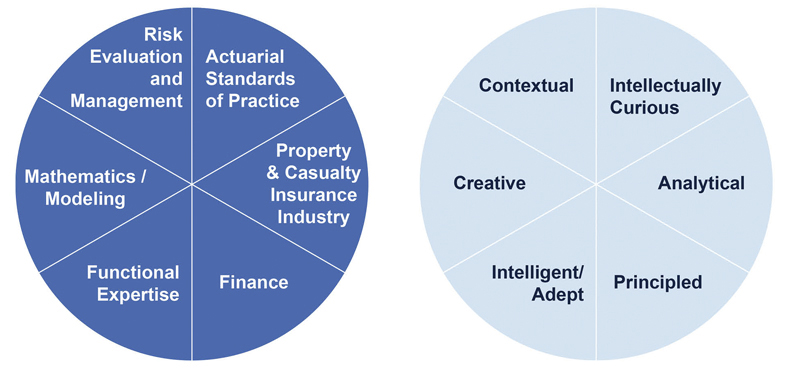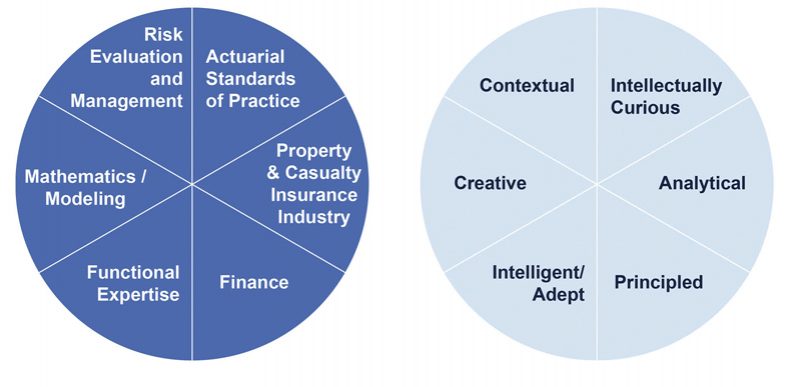By Ken Williams and Carrie Cross
The actuarial field is unique in many ways, including the way we require candidates to follow a structured pathway of requirements leading to our credentials. For the Casualty Actuarial Society (CAS), this pathway consists of a well-defined learning plan consisting of exams, modules, and a professionalism course. The exams are based upon clear content outlines defining what the candidate needs to learn and what readings need to be mastered. Successfully demonstrating knowledge of these materials will lead to the associate or fellowship designations.
For actuaries, however, the learning does not end when the associateship or fellowship credential is awarded. The U.S. Qualification Standards (USQS) state that actuaries must “remain current on emerging advancements in actuarial practice and science that are relevant to the Actuarial Services they provide.” The challenge for actuaries is determining how to focus their future continuing education so that it meets the USQS and the needs of their employer while furthering their career goals.
In terms of career goals, actuaries might contemplate questions such as, “Do I aspire to be a chief actuary someday?” “Do I want to lead a team of reserving actuaries?” Or “If I’m not interested in leading people, do I want to become an expert at data science and analytics?”
Educational opportunities are plentiful: The major actuarial organizations within the United States offer continuing education opportunities throughout the year through in-person conferences, webinars, and publications. But how does an actuary consider these offerings and turn them into a structured learning plan to obtain their career goals? One answer is the CAS Capability Model, which is a new resource available to assist actuaries in developing a plan to achieve their professional objectives.
What is a capability model?
Capability models are used in many professions and industries. At their core, they are visual frameworks that articulate and provide guidance on the traits, skills, and knowledge that are most important within the profession or industry they represent. Most models, including the CAS Model, cover the breadth of the profession and include the information an individual needs from the time they enter the profession through the duration of their career. These models are future-oriented to respond to trends impacting the profession; they are also dynamic in order to evolve as the profession evolves.
Capability models are used by professionals to learn and grow by strategically planning their professional development journey. Educators use them for the development of professional education offerings, and employers use them to ensure the current and future relevancy of their employees. Models are a blueprint for impact and career growth.
Overview of the CAS Capability Model
The CAS designed the CAS Capability Model to look at the full range of skills needed by actuaries and the contributions of actuaries to the industries they support.
The model is divided into three specific areas. The first is knowledge of content areas, such as risk evaluation and management, or actuarial standards of practice (ASOPs). The second area comprises skills to do the job, including communication skills or business acumen. The third area of the CAS Capability Model covers the traits to grow as an actuary, which can include things like intellectual curiosity and creativity.
These areas often overlap. For example, one skill that actuaries should strive for is to be principled. The model defines “principled” as acting with ethics and following applicable principles. To accomplish this, a member would need to increase their knowledge level of professionalism content (e.g., ASOPs and other applicable documents). The member would also want to increase their professionalism skill by ensuring that their actuarial work product follows the Code of Professional Conduct and considers potential ethical situations.
Not everyone is going to develop the same level of ability for every knowledge base, skill, or trait. The CAS Capability Model helps members by specifying several levels inside the framework and demonstrating the abilities required. Level 1 learning will give individuals an understanding of content knowledge and the skills to apply the content. Moving to Level 2, an actuary will have a strong command of individual knowledge, skills, and traits. At the pinnacle of achievement is Level 3 where individuals will have an advanced level of acumen allowing them to solve complex business problems.
“We applaud the CAS for their investment in the Capability Model,” says Julie Joyce, SVP and chief corporate actuary for Travelers. “The model will help actuarial professionals assess their skills across various dimensions and use the tailored recommendations to prioritize where to focus their learning efforts.”

Evolution of the model
One of the first steps in making your professional development plan is to evaluate where you are today. The CAS is developing an online self-assessment tool, which will set the starting point for your learning journey. For now, actuaries can complete an individual self-assessment against the model on their own.
Coming soon, all future CAS educational offerings will be labeled to indicate which section of the CAS Capability Model the offering will meet, as well as the level of skill or knowledge being targeted. You can see what content has already been tagged in the CAS on-demand library if you go to https://www.pathlms.com/cas/courses and browse in our dropdown menu for content related to the specific categories and levels you are looking for.
In the future, based on the self-assessment, a custom learning plan will be provided to help identify CAS educational content that could assist an actuary in moving from one level to the next.
“Continuous learning is at the core of our company’s culture as well as in the actuarial and analytics community,” added Joyce. “We are excited to see the CAS Capability Model continue to evolve as a tool for our actuaries in their development journey.”
Practical application—how you can use the CAS Capability Model
Let’s say you are a recent FCAS and have been promoted to lead a predictive analytics team that is building pricing models for homeowners and personal auto pricing. With these added responsibilities, you may want to focus on developing principled traits to ensure that the group you are leading is making ethical decisions. You decide you are currently between Level 1 (understanding and navigating professional situations) and Level 2 (engaging and guiding ethical decision-making). However, your goal in your new managerial role is to meet advanced Level 3, which will allow you to model ethical behavior and be known as an ethical leader within your organization. With this goal in mind, you seek out educational opportunities to advance your abilities in this trait.
In addition to traits, you examine where you are in terms of content areas knowledge. With your background in predictive analytics, you feel you have met Level 2 in terms of functional ability, which means you are proficient in the analytics area. You decide that you want to gain knowledge that helps you become an expert in researching and developing new techniques that your team can deploy in their pricing function.
Capability model at the CAS Annual Meeting
We invite you to learn more about the evolution of the CAS Capability Model at the CAS Annual Meeting, set to take place November 5–8, 2023, in Los Angeles and virtually online. “I’m excited to see the Capability Model in its full implementation at the CAS Annual Meeting,” says Nora Potter, director of professional education. “Each of our educational sessions at the event will be tagged, allowing members who have self-assessed their skills to be able to seek out the content that will aid in their ‘Journey to the Top.’”
For more information about the CAS Capability Model—including demonstrations of how associates and fellows can each use the tools—visit the CAS website at casact.org. For more information on the CAS Annual Meeting, visit annual.casact.org/.
KEN WILLIAMS, MAAA, FCAS, is the CAS staff actuary. CARRIE CROSS is a partner for strategy and learning at CAS.





